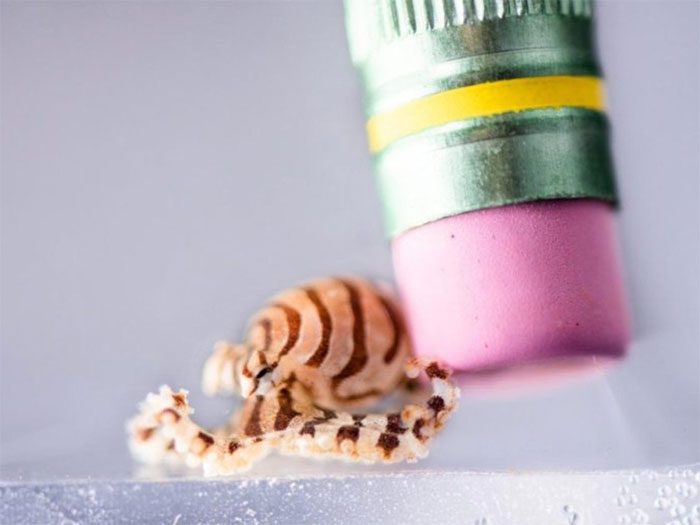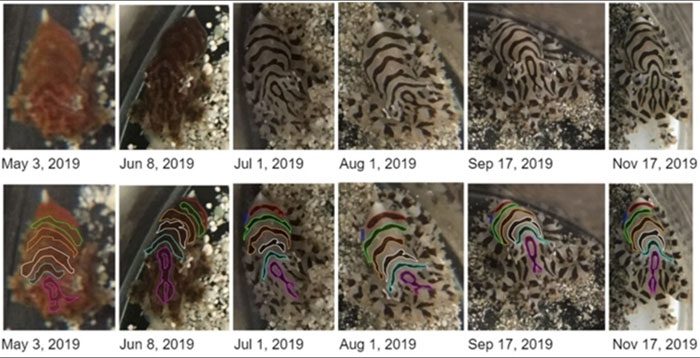Scientists Discover Octopus Patterns as Unique Identifiers, Similar to Human Fingerprints.
According to Science Alert, octopuses are often likened to chameleons of the sea. Thanks to tiny skin structures containing pigments (known as chromatophores, iridophores reflecting colors, and leucophores reflecting light), these mollusks can change their patterns and colors in the blink of an eye.
Moreover, with a flexible body and easily alterable muscle structures, octopuses rarely look the same at any given moment. This variability makes tracking individual octopuses in the wild a challenging task.

Many details about the origin, development, and ecosystem of Octopus Chierchiae remain largely unknown. (Photo: Tim Briggs).
Recently, a study published in PLOS One has identified patterns on the bodies of octopuses through photographic analysis. These patterns remain visible even when the octopus is glowing. The stripes, initially unclear in hatchlings, can be observed under magnification as early as day five.
The findings related to the patterns on octopuses will aid in exploring other species. Specifically, they allow scientists and non-experts to track the Pacific Striped Octopus (Octopus Chierchiae, also known as the Dwarf Zebra Octopus) both in the wild and in captivity through visual observation.
Individuals raised in the lab can be identified through images.
Octopus Chierchiae is a small octopus species inhabiting the intertidal zones along the Pacific coast of Central America. According to scientists, many details about its origin, development, and ecosystem remain unknown.
However, Octopus Chierchiae is a relatively rare species. Therefore, non-invasive sampling methods are essential for studying individuals and populations over time. Scientists recorded the physical development of 25 octopuses from hatchlings and concluded that Octopus Chierchiae has unique and consistent stripe patterns throughout its life.
Upon realizing that each octopus could be identified by its stripes, scientists wondered if laypersons could do the same.
To find out, they began recruiting non-experts (individuals not working in related scientific or biological fields), asking them to observe octopuses older than four weeks.
Subsequently, 38 observers participated in a test where they viewed 20 slides, each displaying two different photos of an octopus (with some photos taken up to 25 weeks apart). Among the 20 slides, 9 displayed images of the same octopus, while the remaining 11 showed images of two different octopuses.
For each slide, observers confirmed whether they believed they were looking at the same octopus. Results showed that 17 of these observers achieved accuracy rates of 95% or higher, with an average score of 90%.
The results demonstrated that individuals raised in the lab could be identified through photos taken at different life stages. This suggests that wild individuals could also be recognized and observed for longitudinal field studies.

Scientists conclude that Octopus Chierchiae has unique stripe patterns that remain consistent throughout its life. (Photo: PLOS One).
Potential of Image Recognition Methods
Typically, tracking animals involves tagging them. However, species with tentacles are notoriously uncooperative when it comes to “tagging.” Moreover, tags can fall off or damage the soft tissue of the octopus.
Thus, tagging is not a feasible option for small species like Octopus Chierchiae. Given these challenges, scientists believe that image recognition is the best method to minimize negative impacts on octopuses while also saving research costs.
Additionally, photographs can capture data such as location, time, behavior, and ecological interactions, providing valuable information about the species.
Prior to this study, the only octopus known to have sufficiently unique markings for image identification was the Wunderpus Photogenicus. Currently, the Pacific Striped Octopus and the Atlantic Striped Octopus (Octopus Zonatus) are the next candidates for similar identification methods.


















































